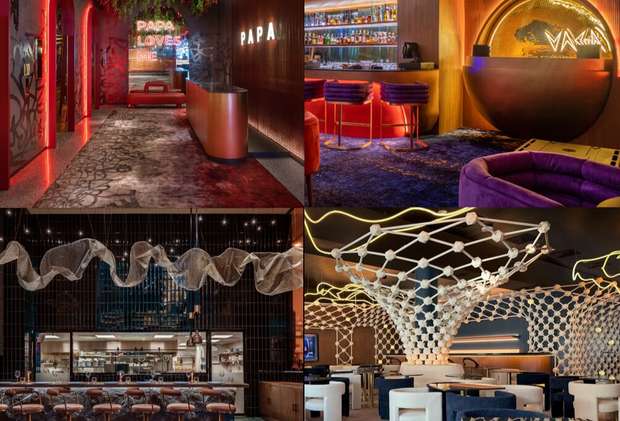The restaurant dining experience design is the key to creating memorable and impactful dining moments. It’s not just about how a space looks, but how it makes guests feel from the moment they walk in. Every element, from lighting and layout to textures and ambiance, plays a role in shaping a seamless experience. In this article, we explore the essential elements that make up the perfect restaurant dining experience design.
Past and Present: From Functionality to Experience
Historically, restaurant design focused on functionality, with standard layouts, conventional color schemes, and a primary emphasis on operational efficiency. The kitchens were designed purely for functionality, and the décor was simple and traditional. However, this paradigm has shifted dramatically in recent years. Modern restaurants prioritize creating holistic, experience-driven environments. This evolution includes flexible and multifunctional spaces, open kitchen concepts, and social media-friendly, Instagrammable spots.
Restaurants like PAPA Dubai exemplify this shift, offering flexible layouts and visually appealing interiors that encourage social media engagement. These spaces are not just about dining; they are about creating memorable experiences that engage all the senses.
Restaurant Dining Experience Design
In today’s competitive market, restaurant dining experience design is more than aesthetics—it’s about crafting emotions. From the moment guests walk in, every detail shapes their perception. A powerful design blends ambiance, functionality, and storytelling. Whether it’s lighting, furniture, or layout, a well-executed design ensures lasting impressions. Discover how thoughtful restaurant dining experience design can transform your space from ordinary to unforgettable.
What is Experience Design in the Restaurant World?
Experience design in restaurants is the art and science of shaping every touchpoint a guest interacts with—from visual elements to emotional responses. It goes beyond interior decoration to focus on how a space makes people feel. Good experience design immerses guests in the brand story and creates a memorable atmosphere that aligns with the cuisine, culture, and values of the restaurant.
Why First Impressions and Visual Design Matter
First impressions happen in seconds. The exterior, signage, lighting, and initial interior visuals determine whether guests feel curious or cautious. A striking yet cohesive visual design not only catches attention but sets expectations. Colors, materials, and branding elements must work together to reflect your restaurant’s personality and quality—because your visual identity is your silent host.
Creating a Welcoming Atmosphere with Ambiance, Comfort & Functionality
Ambiance is the invisible thread that ties everything together. Music, scent, lighting temperature, and spacing influence how guests feel and behave. Combine that with ergonomic seating, clear pathways, and thoughtfully placed fixtures, and you’ve created a space that invites guests to relax, stay longer, and return. Comfort and functionality are the silent heroes behind great experiences.
Smart Furniture & Layout Choices That Shape the Guest Journey
Furniture is more than a design piece—it’s a tool for flow, comfort, and storytelling. Choose furniture that suits your concept, whether cozy and intimate or sleek and modern. Meanwhile, layout planning ensures service efficiency and guest comfort. From waiting areas to table distances and walkways, every inch matters in shaping the journey.
Textures, Lighting & Decorative Elements: The Soul of the Space
Texture adds richness. Lighting sets mood. Decorative elements add character. Combine all three, and you infuse your restaurant with soul. Contrast smooth and rough surfaces, use warm lighting to invite calm, and incorporate unique artwork or custom features to stand out. These details may seem small—but they make a huge emotional impact.
Bringing Nature In: Using Natural Elements for a Fresh Vibe
Biophilic design is a growing trend in restaurant dining experience design. Incorporating plants, wood, stone, and natural light fosters a sense of calm and connection. Green walls, herb planters, or even just natural textures can soften harsh environments and align your brand with wellness, sustainability, and freshness—values that resonate with today’s diners.
Designing Beyond the Plate: Takeaway Packaging & Outdoor Dining
The dining experience doesn’t end at the table. Thoughtful takeaway packaging continues the journey—making your brand memorable beyond the restaurant walls. And with outdoor spaces in demand, consider terraces, patios, or street-side seating as extensions of your ambiance. These areas must carry the same design DNA to maintain consistency and charm.
Ready to Redefine Your Space? Partner with 4SPACE
At 4SPACE, a leading interior design company in Dubai and interior design company in Abu Dhabi, we specialize in creating immersive, functional, and unforgettable restaurant dining experience designs that elevate your brand and delight your guests. With a multidisciplinary team and a passion for innovation, we turn ideas into experiences.
Ready to make a lasting impact? Let’s build something remarkable—together.
FAQ
How would you describe a good dining experience?
A good dining experience combines delicious food, attentive service, comfortable ambiance, and a visually appealing design that reflects the restaurant’s theme. It leaves guests feeling satisfied, welcomed, and eager to return.
How to design a restaurant concept?
Start by identifying your target audience, then choose a theme, cuisine, and overall vibe that appeals to them. Align the interior design, branding, menu, and customer journey to create a cohesive and memorable experience.
What are the 5 great steps for designing a concept?
-
Define your vision and target audience
-
Choose a unique theme or story
-
Develop a menu that supports the concept
-
Design the space to reflect the concept visually and functionally
-
Ensure consistency across branding, service, and atmosphere




